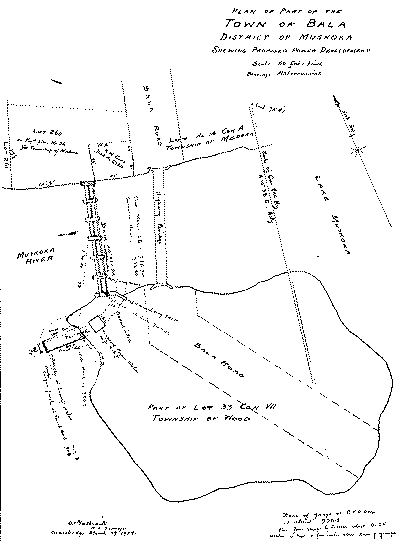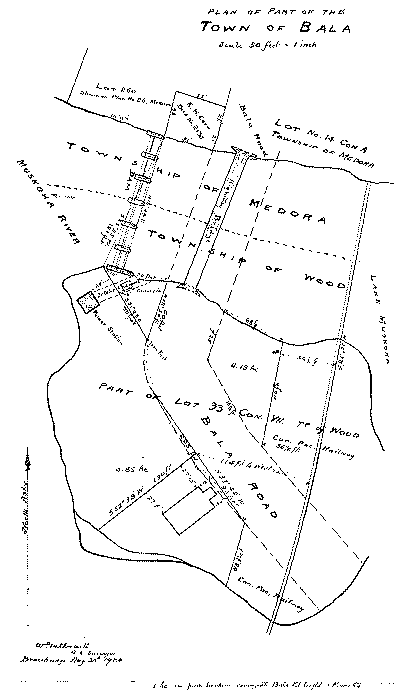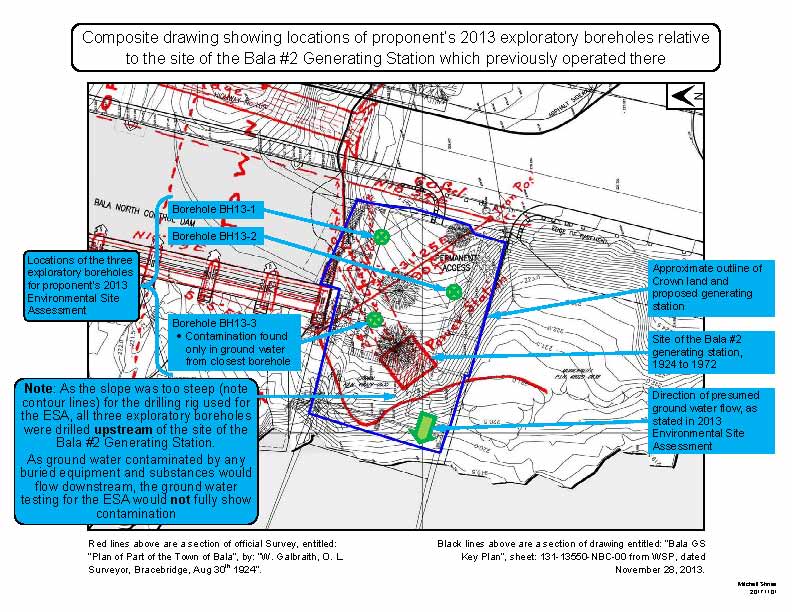Summary
As we have noted for several years (for example, in the article here), the proponent’s environmental investigations have been entirely inadequate, with the result that their work could result in releasing toxic waste such as PCBs into the Moon River, causing irreparable environmental harm. We have therefore submitted the following:
- A request to the Environmental Commissioner of Ontario that the MOECC review the last approval issued to the proponent as it would not protect the environment or public.
- A request to the Environmental Review Tribunal to revoke the last approval issued to the proponent, as this approval was based on inadequate environmental testing by the proponent.
Detail
The Bala #2 Generating Station was built in 1924, and is shown in historical official surveys, such as the March 29, 1924 drawing below (click on it for a larger view), which is entitled: “Plan of Part of the Town of Bala, District of Muskoka, Shewing Proposed Power Development”. The building itself is shown as “Proposed”, and having dimensions of 16′ x 16′.
The survey below was done a few months later, in August 30, 1924, likely because not only has the Bala #2 Generating Station been built (it is no longer referred to as “Proposed”), but the land has been transferred to the Bala Electric Light & Power Company.
A few years later, in 1929, a portion of the land was sold to the Hydro-Electric Power Commission of Ontario, which was how the province came to own the currently-proposed construction site.
That is, it is well-established exactly where the Bala #2 Generating station was located.
The Bala #2 Generating Station operated until 1957, a colour photograph of it is here (this photograph would have been taken before 1954, as that is when the current bridge over the Bala north channel was built). During these 33 years of operation, the machinery (and floor) would have accumulated significant grease and oil.
After being idle for 15 years, in 1972, the Bala #2 Generating Station was demolished. There seems to be no record of what happened to the hazardous materials, whether they were removed or buried. But what is known is:
- From 1929 to 1979 polychlorinated biphenyls (PCBs) were widely used in electrical equipment, such as the “step-up” electrical transformer the Bala #2 Generating Station would have needed.
- PCBs were found to be toxic.
- When the Bala #2 Generating Station was demolished, PCBs were still legal and being used, and there were very few environmental requirements for demolitions.
- When demolishing something that has a pit at the bottom, it is certainly easier and less expensive to leave as much at the bottom that fits, than to hoist it out and figure out where else to dispose of it.
- There may be a rusty and fragile electrical transformer containing PCBs, and old machinery and floor coated with oils and greases buried where the proponent plans on excavating. This proposed excavation, and driving heavy construction vehicles over this area could cause these hazardous substances to be washed into the Moon River, and to contaminate adjacent soil.
In 2013 the proponent completed a Phase II Environmental Site Assessment (ESA) which is supposed to determine the location and concentration of any contaminants. This ESA work included their drilling three exploratory boreholes at the location shown below. The ESA also determined that the ground water flow is to the west, as shown by the green arrow below.
The black lines in the graphic below are from a recent drawing from the proponent, and the red lines are from the above historical survey, rotated and scaled to match the recent drawing as close as possible.
Two important observations are:
- The only test result which exceeded the Ministry of the Environment and Climate Change’s (MOECC’s) guidelines was for Zinc in ground water, and this was from the borehole closest to the likely source of contamination – the site of the Bala #2 Generating Station.
- All three of the boreholes were drilled upstream of the site of the Bala #2 Generating Station.
It is therefore possible that:
- The ground water is far more contaminated that reported, as the contamination would flow downstream away from the boreholes.
- There are PCBs, oils and greases that would be dispersed into the Moon River as a result of the proponent’s planned excavation.
The proponent’s proposed construction site must be treated as the abandoned industrial facility that it is, and there are required steps to protect the environment and public. The proponent must be required to follow these.
We have therefore requested that the proponent be required to stop work until they can show that harmful substances would not be released into the Moon River.



Excellent work. How can we, the public, assist with amplification of your truths, please?
We have a problem in that the Provincial Government can get away with saying “ The North is No Mans Land” ,and insult to injury EXCLUDING the North on Purpose on Ontario Municipal Board appeals ! Where is Patrick Brown , he should be enraged by this . Norm Miller is trying ,but they just ignore him! True North Strong and Free is not looking like this right now. We need to make a LOT of NOISE to be Noticed! We need Democracy and Transparency here with all that is going on. It is a Travesty!